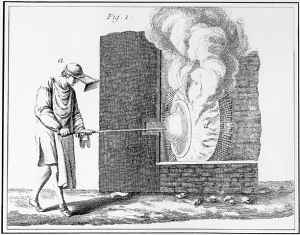HAND-BLOWN GLASS:
MANUFACTURING PROCESS
 BROAD SHEET. Molten
glass is gathered on a blowpipe, and blown to an
elongated balloon shape . The ends are cut off and the
resulting cylinder is split with shears while still hot,
then flattened on an iron plate. This is the forerunner
of the Cylinder process. The quality of the glass was not
good, with many imperfections. Because of the relatively
small sizes blown, it was made into leadlights.
BROAD SHEET. Molten
glass is gathered on a blowpipe, and blown to an
elongated balloon shape . The ends are cut off and the
resulting cylinder is split with shears while still hot,
then flattened on an iron plate. This is the forerunner
of the Cylinder process. The quality of the glass was not
good, with many imperfections. Because of the relatively
small sizes blown, it was made into leadlights.- CROWN GLASS.
Molten glass is gathered on a blowpipe, and a balloon
shape is blown. The blowpipe is removed, a solid
"punty" rod is attached and the glass is spun
rapidly until a disc is formed. The outer portion beyond
the central knob is then cut into panes. By the 18th
Century quality was often very good with an almost
unmarked fire-finished surface. Crown was the preferred
choice for window glass, together with some imported
Cylinder glass until the mid 19th Century.
- BLOWN PLATE.
Produced from Broad Sheet, each sheet of glass was
laboriously hand ground and polished on both surfaces.
The plate was of a sufficient quality and size for
mirrors or coach glasses.
- POLISHED PLATE
Produced by casting glass onto a table and then
subsequently grinding and polishing the glass, originally
by hand, later by machine. An expensive process requiring
a large capital investment.
- CYLINDER BLOWN
SHEET. A similar process to Broad Sheet, except that
larger cylinders are produced by swinging the cylinder in
a trench. The glass is allowed to cool before cutting the
cylinder, which is then re-heated and flattened. Larger
panes and a much improved surface quality result.
Manufactured in the UK in the mid 19th Century,it had
been manufactured in France and Germany (and imported to
the UK) since the 18th Century.
The above methods of
manufacture lasted at least until the end of the 19th Century.
The early 20th Century marks the move away from handblown to
machine manufactured glass.
- MACHINE DRAWN
CYLINDER SHEET. The first mechanical method of drawing
glass, 40 ft high cylinders of glass were drawn
vertically from a circular tank. The glass was annealed
and then cut into 7 - 10ft cylinders, which were then cut
lengthways, reheated and flattened. This process was used
in the UK up to the end of the 1920's.
- FLAT DRAWN
SHEET. The glass was drawn vertically in a flat sheet
until it cooled sufficiently to allow the glass to be
cut. The Belgians invented the original process but it
did not reach the UK until 1919. Horticultural Sheet is
produced by a later variation of this process. The glass
was noted for having a wave in one direction only.
- SINGLE AND TWIN
GROUND POLISHED PLATE. Here the glass is cast and then
subsequently ground and polished on a conveyor belt,to a
fine quality without distortion.
- FLOAT GLASS. A
layer of molten glass is "floated" on to a bath
of molten tin and produces a fine quality of glass, but
with a mirror like reflection, without any wave or
distortion. It is the standard modern method of producing
window glass today.
 BROAD SHEET. Molten
glass is gathered on a blowpipe, and blown to an
elongated balloon shape . The ends are cut off and the
resulting cylinder is split with shears while still hot,
then flattened on an iron plate. This is the forerunner
of the Cylinder process. The quality of the glass was not
good, with many imperfections. Because of the relatively
small sizes blown, it was made into leadlights.
BROAD SHEET. Molten
glass is gathered on a blowpipe, and blown to an
elongated balloon shape . The ends are cut off and the
resulting cylinder is split with shears while still hot,
then flattened on an iron plate. This is the forerunner
of the Cylinder process. The quality of the glass was not
good, with many imperfections. Because of the relatively
small sizes blown, it was made into leadlights.